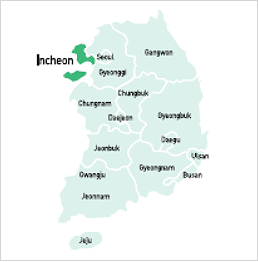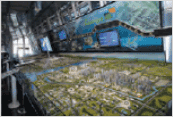
Incheon
Location

Incheon is located in the middle of the Korea peninsula and is not only close to Seoul, the capital city, but also next to the Yellow Sea.At the center of marine transportation, it has served as a bridge between the Korean Peninsula and other countries since olden times.
∙ Mathematical location |
Around 126。37、E, 37。28、N |
∙ Geographical location |
Incheon adjoins the Yellow Sea, and is located in the middle of the Korean peninsula at the down stream of the Han River. |
∙ Geographical location |
Incheon adjoins the Yellow Sea, and is located in the middle of the Korean peninsula at the down stream of the Han River. |
∙ Distance to Seoul |
28 km |
∙ Latitude |
Incheon has the same latitude as San Francisco, Washington and Madrid. |
∙ Area |
1,032.41km2 |
Location
Humans lived in Incheon since the Neolithic Era. Many stone tools from the Neolithic Age were discovered
at Moonhak Mountain and Gyeyang Mountain. Monuments from the Bronze Age were also
discovered in Hagik-dong, Juan-dong, and Moonhak-dong. Biryu, the founder of Baekjae Kingdom, set up a town at Moonhak Mountain and called it "Michuhol" which developed into the present-day Incheon. Its name was later changed to "Maesohol" when it became part of Goguryeo's territory.
Incheon was called "Sosunghyeon" in the Unified Silla era, "Gyeongwongun" in the Goryeo era, and finally during the 13th year of Taejong's reign in the Chosun era (year 1413), its name was changed to the current name of "Incheon". After the Port of Incheon opened in 1883, Incheon became a port city and in the 32nd year of King
Gojong's reign (year 1895), it followed a new system whereby an Incheon government office was set up.
After the Korean government was established in 1945, the autonomous local government system was implemented in August 15, 1949, and a new Incheon City was born with a population of 265,000 people.
- Historical Places in Incheon
-
- Palmido Lighthouse: It was completed in 1903 and first lit on June 1st of the same year. It is currently not in use. (28, Palmi-ro, Jung-gu, Incheon (Mooeui-dong))
- Jayu Park : Built in 1888, it is the first modern style park in Incheon. Chinatown is located in front of it. (1-1, Songhak-dong, Jung-gu, Incheon)
- Naeri Church: Created in 1891, it is the first church in Incheon. The old church building was demolished and reconstructed. (3-1, Uhyeon-ro 67beon-gil, Jung-gu, Incheon (Nae-dong))
- Incheon Post Office: As the first post office in Incheon, it was designated as a Korean Cultural Asset in 1982. (6-ga, Hang-dong, Jung-gu, Incheon)
- Gonghwachun: In year 1920 when trade flourished, overseas Chinese from China thought of creating affordable and tasty food which led to the birth of the first Jajangmyeon (Noodles with Black Soybean Sauce) at Gonghwachun (56-14 Chinatown-ro, Jung-gu, Incheon (Seollin-dong))
- The Past, Present and Future of Incheon
-

Pride of Incheon
 |
Port of Incheon Acting as a gateway to Korea's capital, Seoul, it is the best trading port in the west coast which covers the central districts and the metropolitan industrial zone, one of the largest industrial zones in the country. ∙ Port of Incheon website : https://www.icpa.or.kr |
 |
Incheon International Airport It is the largest airport in Korea, opened in March 29, 2001 as a Northeast Asia hub to cater to the metropolitan air transport demand of the 21st century. ∙ Incheon International Airport website: www.cyberairport.kr |
 |
Incheon Bridge Opened in October 2009, it is the longest bridge in Korea, connecting Songdo International Business District to the Incheon International Airport in Yeongjongdo. ∙ Incheon Bridge website: www.incheonbridge.com |
 |
Inchoen Free Economic Zone In year 2003, it was the first place in Korea to be designated as a key region of the realization strategy for becoming Northeast Asia economic center. Unlike other regions in Korea, business and economic activities of foreign investors are secured in the region with a set of differentiated systems and conditions. ∙ Incheon Free Economic Zone website: www.ifez.go.kr |
 |
Incheon Asiad Main Stadium It was the main stadium of the 17th Asian Games hosted in Incheon Metropolitan City in 2014. To celebrate its opening, a warm-up match between the national soccer teams of Korea and Kuwait was held on its grounds and it was also used for the opening and closing ceremony, as well as Athletics competition of the Asian Games. ∙ Incheon Metropolitan City Facilities Management Corporation website : |
 |
Islands of the West Sea These islands refer to Baengnyeongdo, Yeonpyeongdo, Daecheongdo, Socheongdo and Udo belonging to Ongjingun. The 5 islands of the West Sea are located at the borders and are geographically extremely important, possessing unique natural environments and excellent ecological environments. ∙ Ongjingun culture of sightseeing information website: www.ongjin.go.kr |

